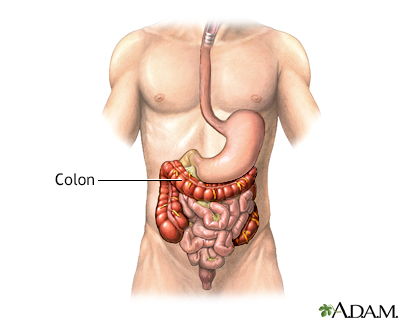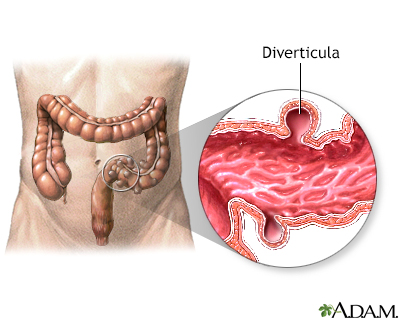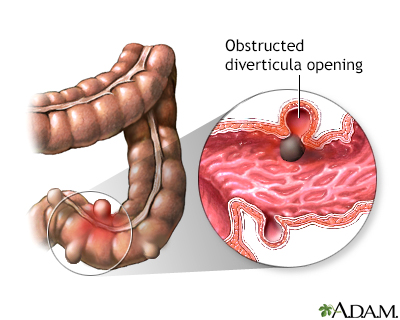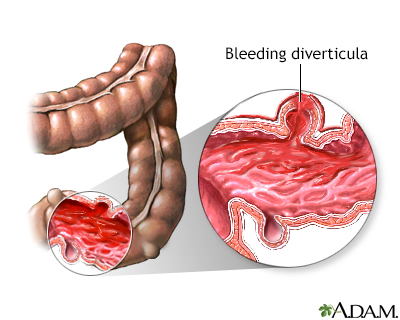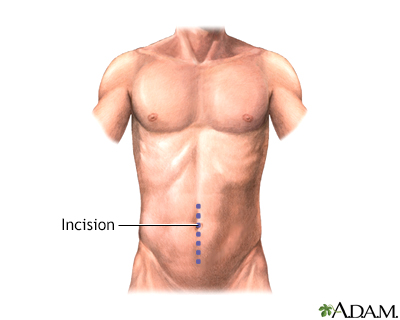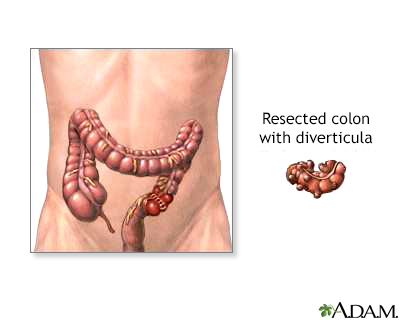Diverticulosis
Diverticula - diverticulosis; Diverticular disease - diverticulosis; G.I. bleed - diverticulosis; Gastrointestinal hemorrhage - diverticulosis; Gastrointestinal bleed - diverticulosis; Jejunal diverticulosisDiverticulosis occurs when small, bulging sacs or pouches form on the inner wall of the intestine. These sacs are called diverticula. Most often, these pouches form in the large intestine (colon). They may also occur in the jejunum in the small intestine, although this is less common.
Causes
Diverticulosis is less common in people age 40 and younger. It's more common in older adults. About half of Americans over age 60 have this condition. Most people will have it by age 80.
No one knows exactly what causes these pouches to form.
For many years, it was thought that eating a low-fiber diet may play a role. Not eating enough fiber can cause constipation (hard stools). Straining to pass stools (feces) increases the pressure in the colon or intestines. This may cause the pouches to form at weak spots in the colon wall. However, whether a low-fiber diet leads to this problem is not well proven.
Other possible risk factors that are also not well proven are lack of exercise and obesity.
Eating nuts, popcorn, or corn does not appear to lead to inflammation of these pouches (diverticulitis).
Diverticulitis
Diverticula are small, bulging sacs or pouches that form on the inner wall of the intestine. Diverticulitis occurs when these pouches become inflame...

Symptoms
Most people with diverticulosis have no symptoms.
When symptoms occur, they may include:
- Pain and cramps in your stomach especially in the left lower abdomen
- Constipation (sometimes diarrhea)
Constipation
Constipation in infants and children means they have hard stools or have problems passing stools. A child may have pain while passing stools or may ...
 ImageRead Article Now Book Mark Article
ImageRead Article Now Book Mark Article - Bloating or gas
- Not feeling hungry and not eating
You may notice small amounts of blood in your stools or on toilet paper. Rarely, more severe bleeding may occur.
Exams and Tests
Diverticulosis is often found during an exam for another health problem. For example, it is often discovered during a colonoscopy.
Colonoscopy
A colonoscopy is an exam that views the inside of the colon (large intestine) and rectum, using a tool called a colonoscope. The colonoscope has a sm...

If you do have symptoms, you may have one or more of the following tests:
- Blood tests to see if you have an infection or have lost too much blood
- CT scan or ultrasound of the abdomen if you have bleeding, loose stools, or pain
CT scan
An abdominal CT scan is an imaging test that uses x-rays to create cross-sectional pictures of the belly area. CT stands for computed tomography....
 ImageRead Article Now Book Mark Article
ImageRead Article Now Book Mark ArticleUltrasound
Abdominal ultrasound is a type of imaging test. It is used to look at organs in the abdomen, including the liver, gallbladder, pancreas, and kidneys...
 ImageRead Article Now Book Mark Article
ImageRead Article Now Book Mark Article
A colonoscopy is needed to make the diagnosis.
- A colonoscopy is an exam that views the inside of the colon and rectum. A small camera attached to a tube can reach the length of the colon.
- This test should not be done when you are having symptoms of acute diverticulitis.
Angiography
Mesenteric angiography is a test used to look at the blood vessels that supply the stomach, small and large intestines, and other internal organs. An...

- Angiography is an imaging test that uses x-rays and a special dye to see inside the blood vessels.
- This test is done to determine a site of bleeding in the GI tract. It may be used if the area of bleeding is not seen during a colonoscopy.
Treatment
Because most people have no symptoms, most of the time, no treatment is needed.
Your health care provider may recommend getting more fiber in your diet. A high-fiber diet has many health benefits. Most people don't get enough fiber. To help prevent constipation, you should:
High-fiber diet
Fiber is a substance found in plants. Dietary fiber, the kind you eat, is found in fruits, vegetables, and grains. Your body cannot digest fiber, s...

- Eat plenty of whole grains, beans, fruits, and vegetables. Limit processed foods.
- Drink plenty of fluids.
- Get regular exercise.
- Talk with your provider about taking a fiber supplement.
You should avoid NSAIDs such as aspirin, ibuprofen (Motrin), and naproxen (Aleve). These medicines can make bleeding and diverticulitis (inflammation) more likely.
For bleeding that does not stop or recurs:
- Colonoscopy may be used to inject medicines or burn a certain area in the intestine to stop the bleeding.
Colonoscopy
A colonoscopy is an exam that views the inside of the colon (large intestine) and rectum, using a tool called a colonoscope. The colonoscope has a sm...
 ImageRead Article Now Book Mark Article
ImageRead Article Now Book Mark Article - Angiography may be used to infuse medicines or block off a blood vessel.
If bleeding does not stop or recurs many times, removal of a section of the colon may be needed.
Removal of a section of the colon
Large bowel resection is surgery to remove all or part of your large bowel. This surgery is also called colectomy. The large bowel is also called t...

Outlook (Prognosis)
Most people who have diverticulosis have no symptoms. Once these pouches have formed, you will have them for life.
Up to 25% of people with the condition will develop diverticulitis. This occurs when small pieces of stool become trapped in the pouches, causing infection or swelling.
Diverticulitis
Diverticula are small, bulging sacs or pouches that form on the inner wall of the intestine. Diverticulitis occurs when these pouches become inflame...

Possible Complications
More serious problems that may develop include:
- Abnormal connections that form between parts of the colon or between the colon and another part of the body (fistula)
- Hole or tear in the colon (perforation)
- Narrowed area in the colon (stricture)
- Pockets filled with pus or infection (abscess)
When to Contact a Medical Professional
Contact your provider if symptoms of diverticulitis occur.
Diverticulitis
Diverticula are small, bulging sacs or pouches that form on the inner wall of the intestine. Diverticulitis occurs when these pouches become inflame...

References
Bhuket TP, Stollman NH. Diverticular disease of the colon. In: Feldman M, Friedman LS, Brandt LJ, eds. Sleisenger and Fordtran's Gastrointestinal and Liver Disease. 11th ed. Philadelphia, PA: Elsevier; 2021:chap 121.
Goldblum JR. Large bowel. In: Goldblum JR, Lamps LW, McKenney JK, Myers JL, eds. Rosai and Ackerman's Surgical Pathology. 11th ed. Philadelphia, PA: Elsevier; 2018:chap 17.
Winter D. Diverticular disease. In: Clark S, Tozer P, eds. Colorectal Surgery: A Companion to Specialist Surgical Practice. 7th ed. Philadelphia, PA: Elsevier; 2024:chap 9.
Review Date: 12/31/2023
Reviewed By: Jenifer K. Lehrer, MD, Department of Gastroenterology, Aria - Jefferson Health Torresdale, Jefferson Digestive Diseases Network, Philadelphia, PA. Review provided by VeriMed Healthcare Network. Also reviewed by David C. Dugdale, MD, Medical Director, Brenda Conaway, Editorial Director, and the A.D.A.M. Editorial team.


